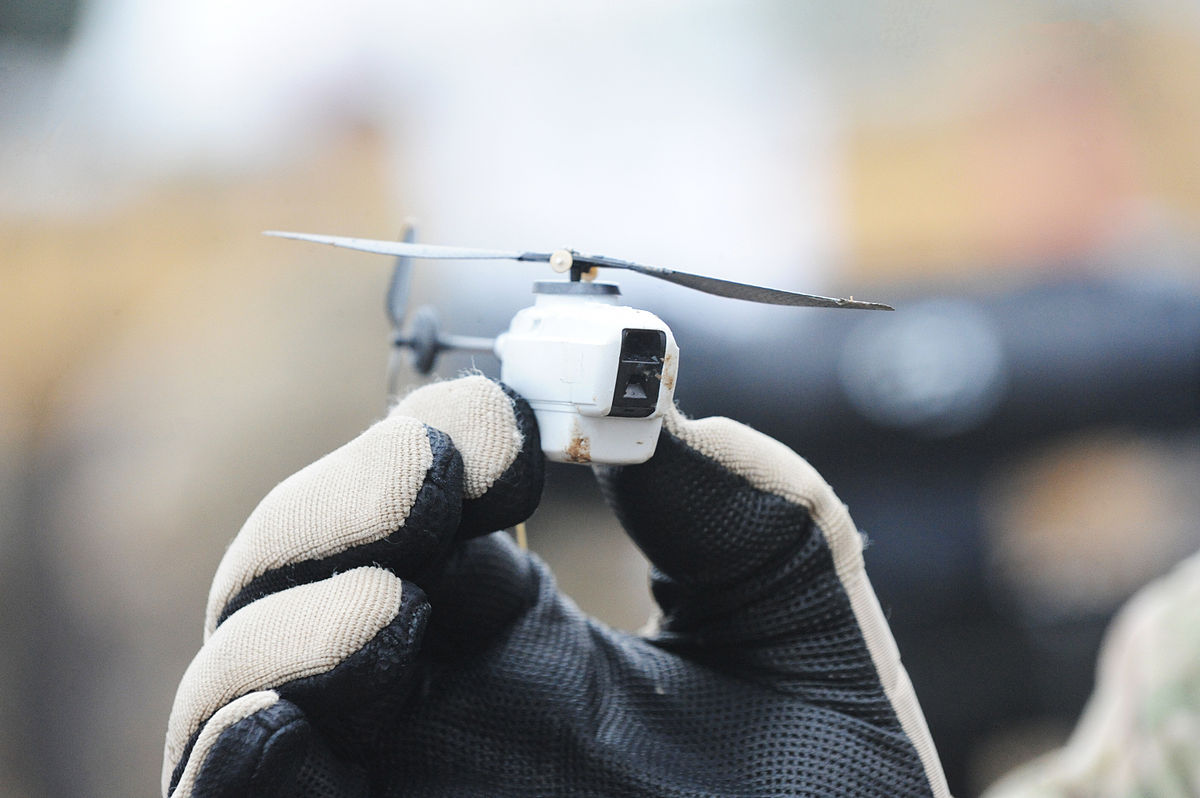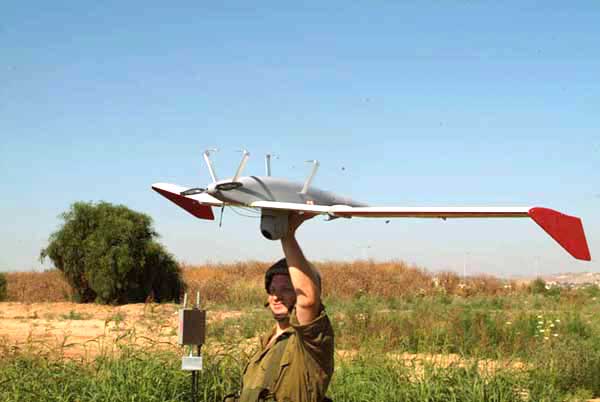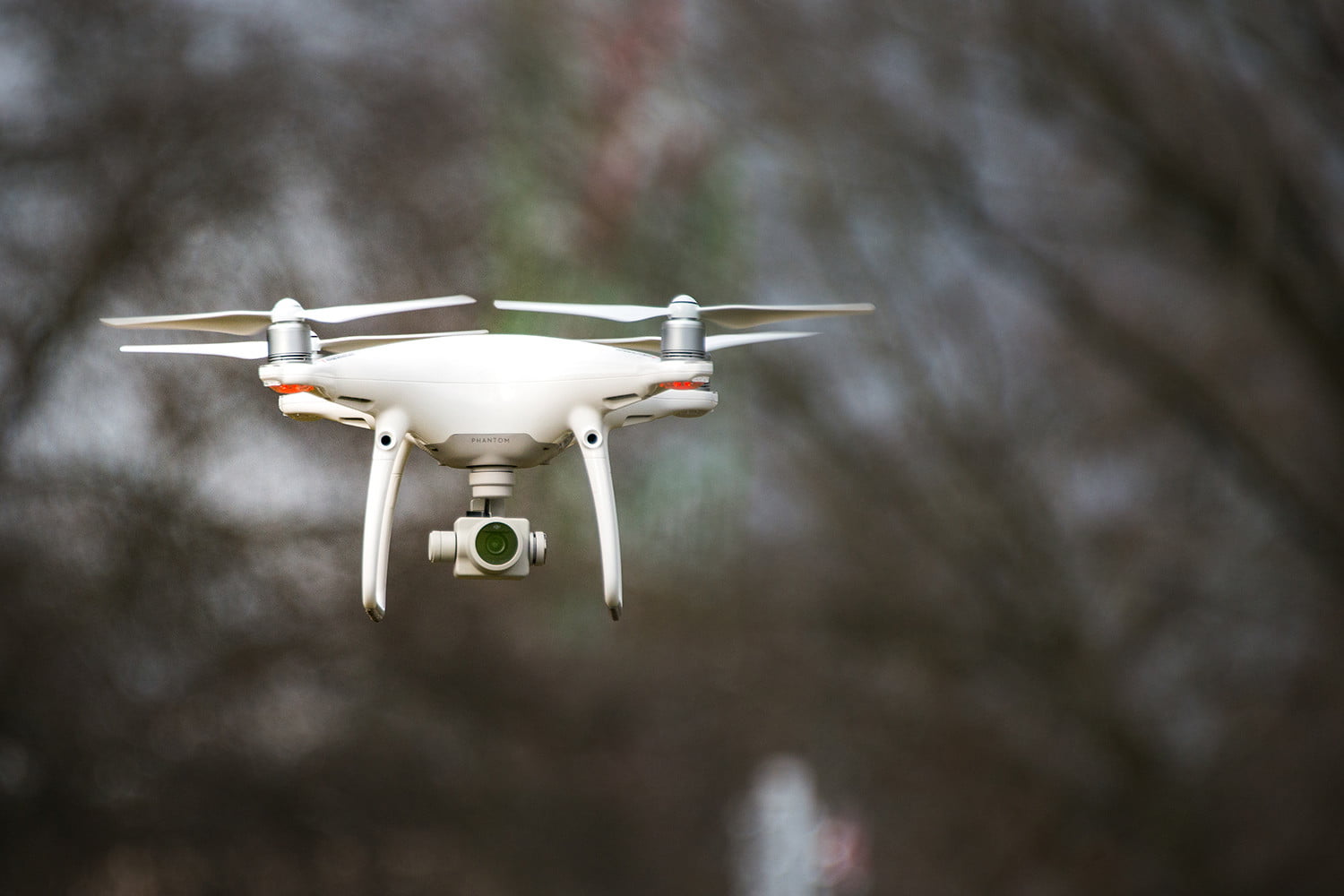
With technology getting ever smaller while needs increase are two phenomenon that are found in almost all walks of life. This trend is particularly apparent in the Unmanned Aerial Vehicles (UAV) domain.
The definition of a micro UAV remains moveable. In comparison to the larger unmanned aircraft that have become ubiquitous with military surveillance and armed operations, much smaller versions of UAVs can range from palm-sized up to shoulder-launched systems, tend to be electrically-powered, and have only an hour or two of endurance at best. A number of different terms are thrown around to define small UAVs, ranging from nano to micro and mini, but on the whole they tend to refer to a family of tactical UAVs that can be rapidly deployed to carry out short endurance surveillance.
The smallest system in known routine operation by US forces is the AeroVironment Wasp-III, which is considered a mini UAV, with the first iteration of the system having weighed less than 1.1 pounds/lb (0.5 kilograms/kg) while empty, and measuring just 380mm (14.9 inches/in) in length. The Wasp-III was brought into operation with the US Air Force and US Marine Corps, but was subsequently upgraded to the Wasp All Environment (AE) model in 2012. The Wasp-AE is true to the concept underpinning the operation of micro UAVs, having an endurance of just 50 minutes, and weighing 2.9lb (1.3kg), the aircraft is 760mm (29.9in) long with a one metre (3.3 feet/ft) wingspan, according to the manufacturer’s specifications. The company says that the hand-launched Wasp-AE is operated “virtually undetected”, and its mechanically-stabilised optronics gimbal payload can transmit imagery in high winds. The aircraft lands through a deep-stall on water or land, and can be operated manually or programmed for autonomous operation using the Global Positioning System satellite constellation.

The Wasp-AE/III came about from a project involving the company and the US Defence Advanced Research Projects Agency (DARPA) to develop a portable frontline system that would complement the larger RQ-11A/B Raven system also developed by AeroVironment. DARPA and AeroVironment have explored even smaller UAVs together, through the Nano Air Vehicle project, through which the agency tasked the company to develop a remotely-operated, life-sized version of a hummingbird. Revealed in 2011, the UAV had to replicate the hummingbird by being able to fly in all directions while replicating the creature’s physical appearance, so as not to give away its real role as a surveillance aircraft. The project won awards for its innovation, but since 2011, very little has been revealed on the progress and viability of a system like this, and AeroVironment was unable to comment on any possible ongoing work in this area. The technology author David Hambling has stated that the micro UAV seen in the 2015 thriller Eye in the Sky is a copy of the hummingbird UAV developed by DARPA and AeroVironment.
As shown by the Wasp-AE/III, military UAVs are getting smaller, and the US Army and Marine Corps have assessed and operated a palm-sized system, in the guise of the Prox Dynamics/FLIR Systems Black Hornet. Most widely associated with the British Army, which brought the system into its core equipment inventory in 2015, the Black Hornet is a nano single-rotor UAV, that has been praised by UK troops for its ability to provide short endurance, stealthy, urban surveillance. FLIR Systems, which provides the aircraft’s Lepton optronics, has been notably reserved on providing information on the acquisition and how it will place the micro UAV into new markets, although Kevin Tucker, the firm’s vice president and general manager, issued a blanket overview of the acquisition online in November 2016: “All generations of the Black Hornet offer our Lepton thermal product to integrate thermal imaging with electro-optical sensors, to provide soldiers with the ability to see in complete darkness or through smoke or obscurants,” Mr. Tucker said: “This was a critical need by many customers and the Prox Dynamics and FLIR Systems teams have already formed an extremely effective working relationship.” He added that the Black Hornet is “revolutionary in many ways,” most notably because it is the smallest and lightest UAV available weighing the equivalent of three pieces of paper. The Black Hornet uses a single main rotor, and can fly for some 25 minutes at up to 21.5 knots (39.8 kilometres-per-hour) over a one mile distance. One system comprises two aircraft, so that one can be charged while the other is operated: “The Black Hornet is a flying sensor, rather than a drone, as it is a highly optimised airborne vehicle that is designed to carry specific electro-optical sensors … It is a true personal sensor system, as the complete kit is easy for one person to carry and have immediately accessible on the outside of their gear,” Mr. Tucker said in a statement supplied to Armada. FLIR Systems says that the Black Hornet has been in use by in excess of twelve military customers, including the US Army and US Marine Corps and the UK Ministry of Defence, but little detail has been revealed on all but the British Army, which remains the most prominent of all customers. Norway and Australia are also believed to operate, or to have tested, the system.

UAVs such as the Black Hornet have traditionally been attractive to special forces, but now such aircraft are increasingly rolling out to conventional forces and border security agencies, FLIR Systems said. Mr. Tucker continued that the use of this type of UAV is actually replacing other variants of unmanned aircraft. UAVs flying overhead to collect intelligence on a situation may simply draw attention to the fact that forces are nearby, but with a micro UAV like Black Hornet, information can be collected stealthily, without the UAV being observed and without troops actually having to enter the area: “Rather than entering the village with little information, a solider equipped with a Black Hornet can deploy it from a safe distance, fly it over buildings and obstacles using the visible and/or thermal sensors,” Mr. Tucker added: “They can fly it without revealing their location, gather critical real-time video intelligence, and then with significantly better situational awareness finalise their plan to enter the area … The Black Hornet is an essential tool of the modern battlefield and other security situations, and customers using them today understand the value they bring to individual personnel and small teams.”
Another area that US forces have explored is the en masse deployment of multiple micro UAVs from an inhabited aircraft. Most recently, in October 2016, the Department of Defence’s (DOD) Strategic Capabilities Office (SCO), which traditionally kept research efforts close to its chest, revealed information on the deployment of 103 MT Lincoln Laboratory Perdix UAVs from three US Navy Boeing F/A-18E/F Super Hornet fighters. Partnered with the navy’s Naval Air Systems Command, the two demonstrated “one of the world’s largest micro drone swarms,” according to a US DOD press release announcing the news at the navies’ Naval Air Weapons Station at China Lake in California; a concept which could ultimately be used to penetrate enemy air defences. This is because large numbers of such UAVs could be used to penetrate hostile integrated air defence systems to deluge an area with aircraft, and hence radar returns thus helping to mask attacking aircraft, or to overwhelm those defences: “The micro drones demonstrated advanced swarm behaviours such as collective decision-making, adaptive formation flying, and self-healing,” the DOD statement continued. Perdix UAVs are not pre-programmed to fly individually, but instead fly as one collective, adapting to each other “like swarms in nature,” SCO director, William Roper, added in the press release: “Due to the complex nature of combat, Perdix (UAVs) are not pre-programmed synchronised individuals, they are a collective organism, sharing one distributed brain for decision-making and adapting to each other,” Mr. Roper added: “Because every Perdix communicates and collaborates with every other Perdix, the swarm has no leader and can gracefully adapt to drones entering or exiting the team.”

Captain Birdeye
However, some manufacturers are not seeing a requirement to develop the very small end UAVs, and are instead concentrating on mini systems. Israel Aerospace Industries, whose Malat division develops some well-known UAVs such as the Heron family of Medium-Altitude, Long-Endurance (MALE) UAVs, is not focusing on anything smaller than mini unmanned aircraft. Dan Bichman, marketing manager of the division, told Armada that the 12.8lb (5.8kg) Birdeye-400 is the smallest system it will offer, because it is meeting all market requirements: “For the military and paramilitary market, I think the Birdeye-400 is the smallest one we’ll lead with, and it looks like we’ll stay there in the future,” he said: “We are always trying to have our hand on the pulse and see what the market is asking for, and we are trying to be as responsive as we can be … We are thinking of improving the system continuously, and adding more capability while staying in the same size system. Once we are happy with the UAV, the improvements will be seen in better payloads and improving the capability for operational missions.”

The Birdeye-400 and Birdeye-650 variants are both electrically-powered mini UAVs, with the former having been in operations for some ten years: “We are trying all of the time to keep the systems updated, and through this we have used stronger batteries,” Mr. Bichman said: “We started with one hour or less endurance, and we are now talking about 1.5 hours, but the basic system is the same.” He added that within the mini category, customers are looking for a small system that can be carried in a backpack: “and they are happy with what we have.” The two small systems carry small payloads of between 2.2lb (one kilogram) and 2.3lb (1.5kg), and their endurance is between one and a half hours and five hours, according to the manufacturer.
One area that is reduced in size is payloads, which Mr. Bichman said, can either allow for more sensors to be integrated onto one UAV, or allows for even smaller UAVs to carry payloads that were previously exclusively reserved for larger airframes: “We absolutely feel that as technology improves the payloads get smaller, so we can carry more payloads on a particular system, or use them on a smaller system,” he said. Excluding the nano systems, mini and small-sized UAVs are not exclusive to the military, as many commercial and hobby systems fall into similar weight categories. Take the DJI Phantom family of UAVs: the firm’s quadrotor UAVs have become synonymous with both professional and amateur non-government use of UAVs, being an accessible yet capable small UAV that can be bought for some $1000. However, the accessibility of such technology means that it is open to exploitation, and in the wrong hands can essentially be used as a weapon.
Islamic State of Iraq and Syria (ISIS) militants are being targeted by US and coalition armed UAVs in both Iraq and Syria, most notably by the General Atomics Aeronautical Systems MQ-9 Reaper MALE UAVs, but ISIS has become wise to the benefits of using such technology against the coalition, albeit on a much smaller scale. Images released by the insurgent group on social media this January show homemade grenade mechanisms attached to the underside of Phantom UAVs, which have been used to drop the weapon on ground forces and civilians in the areas of Iraq and Syria that the group is trying to consolidate its control of. This means that not only are coalition forces trying to counter ISIS’ infrastructure and the militants themselves, they are also having to locate, track and neutralise makeshift armed mini UAVs.
Notably, ISIS’ use of UAVs to carry explosives is a negative shift for western forces deployed on the ground in Iraq and Syria helping to combat the insurgent organisation. According to the Combating Terror Centre (CTC) based at the United States Military Academy in New York State, an October 2016 use of an armed UAV by the group was the first lethal attack of its kind: “In early October 2016, the group … killed two Kurdish soldiers with an explosive device hidden inside a drone,” the centre reported: “While (insurgent) groups have long had a fascination with drones and experimented with their use, the incident was a first for (such a) group, and it potentially represents the leading edge of a wave of similar incidents that could follow in the months, years and decades ahead.” ISIS is therefore the only organisation employing political violence known to have killed using a UAV, the centre claimed. While the Iraqi and Syrian armies, for example, are claiming that they are successfully countering this threat, and the hobbyist technology itself is not sophisticated enough to defend itself from attack, the possibilities the technology offers could be far more serious.
While grenade deployments are dangerous in themselves, the deployment of chemical or biological weapons from a small UAV could be devastating, and ISIS is an organisation that seems willing to use anything they can to achieve what the group considers to be a battlefield success. The CTC continued that ISIS’: “use of drones has certainly complicated some conflicts, but the use of this technology by (insurgents) has yet to change or significantly alter the direction of any conflict, and so the broader impact of this tool thus far has been quite limited.”

While micro and mini UAVs have been used in certain operations for some years, notably during the US-led interventions in Afghanistan and Iraq, according to open sources, it seems the possibilities they offer has not yet been fully exploited. Only the more sophisticated NATO (North Atlantic Treaty Organisation) nations seem to be operating the palm-sized military grade systems like the Black Hornet, although many more, both within and outside of NATO, could benefit from a technology that aids urban operations so greatly.
The fact that they are not operating them could point to the cost associated with operating a technology that is now packaged into such a small casing, although the commercialisation of other technology into smaller forms, take the effective incorporation of the computer into the ubiquitous smartphone, which shows that it can be made accessible. Another reason for the lack of micro, nano and mini UAV use could be the shortage of systems. These three categories are often clumped together, but the capabilities between the Black Hornet and Birdeye-400 (see above) can vary, possibly pointing to an absence of viable options to cover the entire market. The Black Hornet, for example, is designed to be used by special forces and ground troops wanting a quick picture of a potentially dangerous environment that they are about to enter, while the Birdeye-400’s 90-min endurance allows for a more prolonged, albeit still relatively short, overwatch of an area.
One trend that is emerging in this market is the replacement of other types of UAVs with these much smaller aircraft, which is a generational shift from unmanned systems merely replacing conventional aircraft. While some may still not see the appeal of unmanned systems taking over the dangerous roles that manned platforms have traditionally carried out, on the whole autonomy is now commonplace within militaries the world over, and operators are not simply accepting that the UAV they have in their fleet is the limit of their capability, but are instead looking at new ways of making it more effective. The size and relative stealth of a micro UAV is central to its appeal, as it offers conventional and special forces alike the ability to quickly provide surveillance over a contested area that would be dangerous to enter without carrying out a prior reconnaissance. Micro UAV technology may yet gain momentum in its adoption by armed forces around the world as such technology becomes more accessible and more affordable.
by Beth Stevenson












